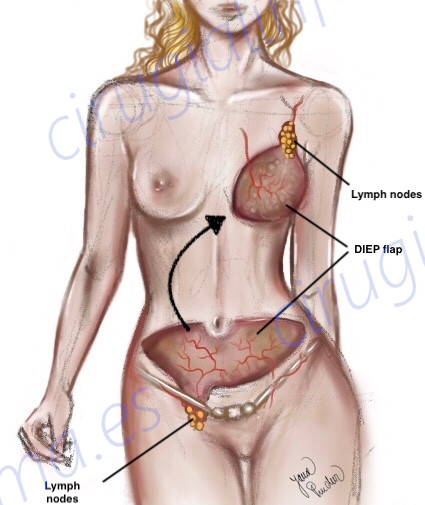
Lymphedema associated with breast cancer
In Europe, the main cause of lymphedema is lymph node resection for the treatment of breast cancer. Breast reconstruction can be associated with the treatment of lymphedema.
Types of breast reconstruction
There are two types of breast reconstruction:
Reconstruction with autologous tissues, using flaps
It consists of transplanting the patient’s own tissues from another part of the body to reconstruct the breast. The first choice is usually the abdominal tissue (skin and fat), which is known as DIEP flap, although there are other options.
This technique offers fewer complications by avoiding the use of implants, provides a more natural result than implant reconstruction, and allows a “life-long” reconstruction without the need for future surgery. This type of reconstruction is usually necessary when the patient has undergone previous radiation therapy.
Reconstruction with tissue expanders and breast implants
It is generally performed in two surgical stages. In the first intervention, an empty expander or prosthesis is placed, which is subsequently filled (expanding) with saline solution until the desired volume is achieved. Once this volume is achieved, a second surgery is performed in which the expander is exchanged for a definitive prosthesis. We recommend this option only when an autologous reconstruction is not possible.
If you have had an implant reconstruction or have not been reconstructed, breast reconstruction with autologous tissue may be performed in conjunction with a lymph node transplant.
Principles of this combination
- Eliminate scar tissue and prosthetic material: this tissue causes greater difficulty for the passage of lymphatic tissue.
- Transplantation of lymph nodes to the axillary area: the transplanted lymph nodes produce growth factors that allow the formation of absorb lymph; in addition, this new transplanted tissue decreases the scar in the affected area.
- Breast reconstruction using own tissue (fat and skin): it allows a more natural and “for life” reconstruction, without the need for future implants replacement surgeries.
- Aesthetic benefit: by obtaining fat and skin from another area, generally from the belly, we can improve the appearance of this area.
Surgery Duration
6-7 hours.
Surgical Technique
The DIEP abdominal flap is designed in the same way as to perform a tummy tuck (cosmetic procedure in which excess skin and fat are removed from the belly), placing the scar in the suprapubic region and around the belly button. The abdominal tissue, with an artery and a vein, is obtained. In addition, lymph nodes of the adjacent inguinal area are associated.
These lymph nodes collect fluid from the trunk and lower limb area. Indocyanine green is used to avoid taking the lymph nodes that collect fluid from the leg. In this way, we can select lymph nodes that are NOT associated with the leg and prevent lymphedema in the leg. Subsequently, the abdominal tissue is used to shape the new breast, and the lymph nodes are positioned in the axillary area. Previously, the scar tissue was removed.
Finally, using microsurgery techniques, the artery and vein in the abdominal tissue are connected to another artery and vein in the recipient area in the chest. These connections (anastomosis) are made under high magnification microscopy and very fine surgical suture.
Admission to hospital:
3-7 days.
Postoperative:
It is necessary to control the flap during the first days. The sutures (stitches) on the skin are removed after 2 weeks. Upon discharge, you will be able to walk and live a relatively normal life avoiding exercise during the first 6 weeks.
It is recommended to wear a compression garment for the abdomen for 6 weeks and an underwire bra for 6 months. In addition, you should wear a compression garment on the operated limb and start manual lymphatic drainage. You should avoid the massage on the lymph node transfer (armpit). Sun protection is essential at least for the first year.
Treatment planning
Surgical treatment of the lymphedema should be considered if there is no resolution of the lymphedema after 6 months of conservative treatment. The most advanced techniques to improve lymphedema are based on lymphovenous anastomosis and lymph node transfer.
Breast reconstruction (DIEP flap) and lymph node transfer from the groin to the axilla.

